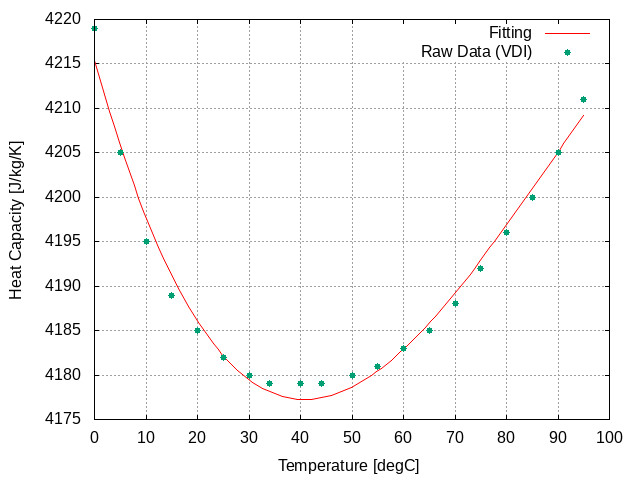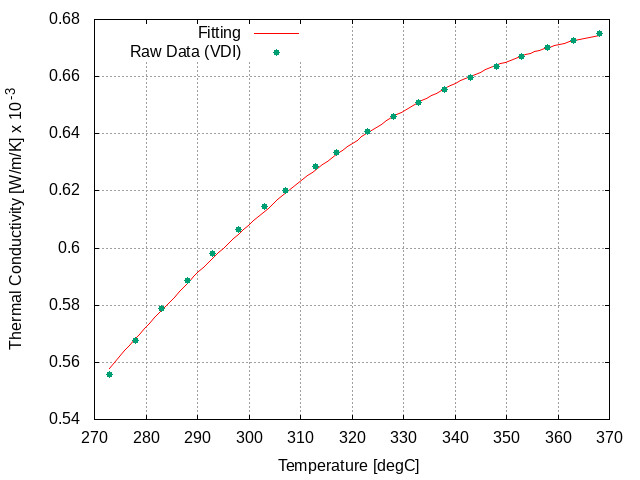Temperature-Dependent Thermophysical Properties for Pure Water
The OpenFOAM® thermophysicalProperties file for water (polynomial approach)
Water is an essential fluid in our world. Even in computational fluid dynamics, it is a characteristic fluid that appears in many analyses. In some cases, one needs the buoyancy effect or temperature-related data, and hence and therefore, temperature depended data are required. I also had a few calculations that need temperature-dependent water properties. In OpenFOAM®, we can use the polynomial approach for temperature-dependent physical property data. However, I always had to derive them again and again, as I forgot to save the file to an appropriate location where I can find them. Fortunately, I found the data during the website-relaunch. Therefore, I decided to put the polynomial derivation into my blog for two reasons: (a) I know where to pick it up fast, and they will not vanish anymore, and (2) everybody can use it. The polynomials are based on pure water in the range between 0 °C < T < 100 °C at atmospheric pressure 101325 Pa.
As already mentioned, OpenFOAM® offers a polynomial approach. Here, the fluid properties, namely the density, the molecular viscosity, the heat capacity, and thermal conductivity, are calculated by using the polynomial functions. The raw data for generating the polynomial functions are taken from the VDI Wärmeatlas.
#------------------------------------------------------------------------------
#
# Data from VDI Waermeatlas (2013)
# Tobias Holzmann
# 12.06.2020
#
#------------------------------------------------------------------------------
# T rho cp x 10^3 mu x 10^-6 lambda x 10^-3
# [C] [kg/m^3] [J/kg/K] [kg/m/s] [W/m/K]
#------------------------------------------------------------------------------
0 999.84 4.219 1791.0 555.65
5 999.97 4.205 1518.2 567.79
10 999.70 4.195 1305.9 578.78
15 999.10 4.189 1137.6 588.80
20 998.21 4.185 1001.6 598.01
25 997.05 4.182 890.02 606.52
30 995.65 4.180 797.22 614.39
34 994.38 4.179 733.73 620.29
40 992.22 4.179 652.73 625.84
44 990.64 4.179 585.35 628.92
50 988.05 4.180 546.52 640.64
55 985.71 4.181 503.36 646.04
60 983.21 4.183 466.04 651.02
65 980.57 4.185 432.91 655.59
70 977.78 4.188 403.56 659.78
75 974.86 4.192 377.42 663.58
80 971.80 4.196 354.06 667.01
85 968.62 4.200 333.08 670.08
90 965.32 4.205 314.18 672.80
95 961.89 4.211 297.09 675.17
#------------------------------------------------------------------------------
The data provided above are used in combination with Gnuplot to perform a polynomial fit. For the density and thermal conductivity, a polynomial of second order was used: f(T) = AT² + BT + C. The dynamic viscosity and heat capacity was fitted by using a cubic polynomial: f(T) = Ax³ + Bx² + Cx + D. The polynomial coefficients are presented now. Furthermore, the comparison with the raw data is given. Thus, using the data below (the polynomials), you should make sure that the temperature is not going beyond the polynomials' limits because non-physical values appear beyond these limits. Therefore, it will influence the stability of your calculation and probably give you a division by zero, especially for the cubic polynomials. To stabilize this, one can use the object function of OpenFOAM®, e.g., the »limitTemperature« capabilities.
Density Fitting
A = -0.00365471 kg/m³/K²
B = 1.93017 kg/m³/K
C = 746.025 kg/m³

Heat Capacity Fitting (cp)
A = -0.000127063 J/kg/K²/K²
B = 0.13736 J/kg/K³
C = -48.6714 J/kg/K²
D = 9850.69 J/kg/K

Dynamic Viscosity Fitting
A = -2.80572e-9 kg/m/s/K³
B = 2.90283e-6 kg/m/s/K²
C = -0.00100532 kg/m/s/K
D = 0.116947 kg/m/s

Thermal Conductivity Fitting
A = -9.29827e-6 W/m/K³
B = 0.0071857 W/m/K²
C = -0.710696 W/m/K

OpenFOAM®`s Thermophysical Property File for Pure Water
For a fast OpenFOAM® set-up, one can copy-paste the text below and insert the entire content into the »thermophysical« file, which is located in the constant folder of your project directory. Feel free to modify the data to fit your needs. The thermodynamic data file is related to the polynomial fitting given above. Since OpenFOAM® version 8, a new thermophysical approach can be used namely the »reciprocal polynomial fit«. However, the below-given data uses the common polynomial approach.
/*--------------------------------*- C++ -*----------------------------------*\
========= |
\\ / F ield | OpenFOAM: The Open Source CFD Toolbox
\\ / O peration | Website: https://openfoam.org
\\ / A nd | Version: dev
\\/ M anipulation |
\*---------------------------------------------------------------------------*/
FoamFile
{
version 2.0;
format ascii;
class dictionary;
location "constant";
object thermophysicalProperties;
}
// * * * * * * * * * * * * * * * * * * * * * * * * * * * * * * * * * * * * * //
thermoType
{
type heRhoThermo;
mixture pureMixture;
transport polynomial;
thermo hPolynomial;
equationOfState icoPolynomial;
specie specie;
energy sensibleEnthalpy;
}
mixture
{
specie
{
molWeight 18.0;
}
thermodynamics
{
CpCoeffs<8> (9850.69 -48.6714 0.13736 -0.000127063 0 0 0 0);
Sf 0;
Hf 0;
}
equationOfState
{
rhoCoeffs<8> (746.025 1.93017 -0.00365471 0 0 0 0 0);
}
transport
{
muCoeffs<8> (0.116947 -0.00100532 2.90283e-6 -2.80572e-9 0 0 0 0);
kappaCoeffs<8> (-0.710696 0.0071857 -9.29827e-6 0 0 0 0 0);
}
}
// ************************************************************************* //

